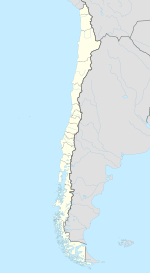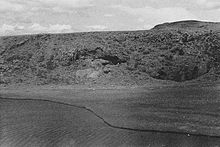Fell's cave
Coordinates: 52 ° 2 ′ 45.1 ″ S , 70 ° 3 ′ 52.8 ″ W.
Fell's Cave ( English Fell’s Cave - Spanish Cueva de Fell ) is a semi-cave with archaeological finds from the American Paleolithic between 9000 and 8000 BC. BC, in Chilean Patagonia . It is located directly on the Argentine border, near the Strait of Magellan in the valley of the Río Chico. The Abri was discovered in the 1930s and mostly excavated around 1970. The site provided evidence that humans had settled in the extreme south of America shortly after the end of the last ice age . In 1977, an even older site was recognized in Monte Verde .
Research history
The Cueva de Fell was discovered by Junius Bird (1907–1982) in 1936/37 and examined for the first time archaeologically. Between 1952 and 1958, French archaeologists worked with the landowner John Fell, after whom Bird gave the site its name. In a sampling from 1968 and a joint excavation campaign in 1969/70 by Bird and Fell, 14 C data from the site were collected for the first time . The samples from the excavations from 1968 to 1970 are archived in the American Museum of Natural History in New York City , and from 2011 they could be re-examined using modern methods.
Findings and meaning
In the half-cave there are quaternary sediments about 2.5 m thick. Bird subdivided the archaeologically relevant layers into five horizons, ranging from the Young Pleistocene to near the present. In the lowest horizon he found a total of 17 fishtail projectile points , a shape that has been found in many places in South America and is considered the South American equivalent to the projectile points of the North American Clovis culture . In the deepest areas he found the bones of two extinct megaherbivores , the giant sloth Mylodon and a horse Hippidion, as well as tools made of stone and bone.
For sampling, Bird divided the five horizons into a total of 23 layers, of which the bottom three (23-21) showed no artifacts or other cultural traces. In layer 20 a fireplace and a fishtail projectile were found, in layer 19 the fireplace continues upwards. A new fireplace appears in shift 18. This find situation made it possible to date the fishtail projectile using charcoal from the fireplaces.
The original dating by Bird in the early years of radiocarbon dating provided ages for strata 18 through 20 of 10,080 ± 160 years, 10,720 ± 300, and 11,000 ± 170 years. The more recent investigations of the same samples using accelerator mass spectrometry corrected these age determinations. Now the information can be corrected to 10,359 ± 30, 10,657 ± 40 and 10,835 ± 50. Using the current calibration curve, this results in an age of 12,390–12,170, 12,700–12,640 and 12,700–12,750 cal BP . The new data fit the findings from Fell's Cave into the age range of other fishtail projectiles found in other locations in southern South America, all of which fall in the range between 12,100 and 12,800 cal. BP.
The southern parts of today's Chile were inhabited both in the swamps on Monte Verde (10,500-9,500 BC) and in the drier areas on the Cueva de Fell. The half-cave was built around 10,000 BC. Occupied by hunters who left layers of rubbish behind. The hunting weapons and tools of the Cueva Fell correspond to the older ones from Monte Verde. So they were part of a longstanding New World tradition.
Fell's Cave was proposed as a UNESCO World Heritage Site by Chile in 1998 , along with the nearby Pali Aike Cave in the Pali Aike National Park .
literature
- Junius Bouton Bird: Travels and Archeology in South Chile . University of Iowa Press 1988
- Michael R. Waters, Thomas Amorosi, Thomas W. Stafford, jr .: Redacting Fell's Cave, Chila and the Chronological Placement of the Fishtail Projectile Point. In: American Antiquity , Society for American Archeology , Volume 80, No. 2 (April 2015), pp. 376-386
Web links
- Metropolitan Museum of Art: Heilbrunn Timeline of Art History - Fell's cave (English)
- Pictures of fish tail spears (English)
- Tony Baker: Late Pleistocene and early Holocene hunter-gatherers of the Pampas and Patagonia, Argentina and Chile (English)
Individual evidence
- ↑ Waters, Amorosi, Stefford 2015, p. 376
- ↑ Waters, Amorosi, Stefford 2015, p. 378 f.
- ↑ Waters, Amorosi, Stefford 2015, pp. 379–381, 382
- ↑ UNESCO: Fell and Pali Aike Caves on the World Heritage List of Suggestions (English)

